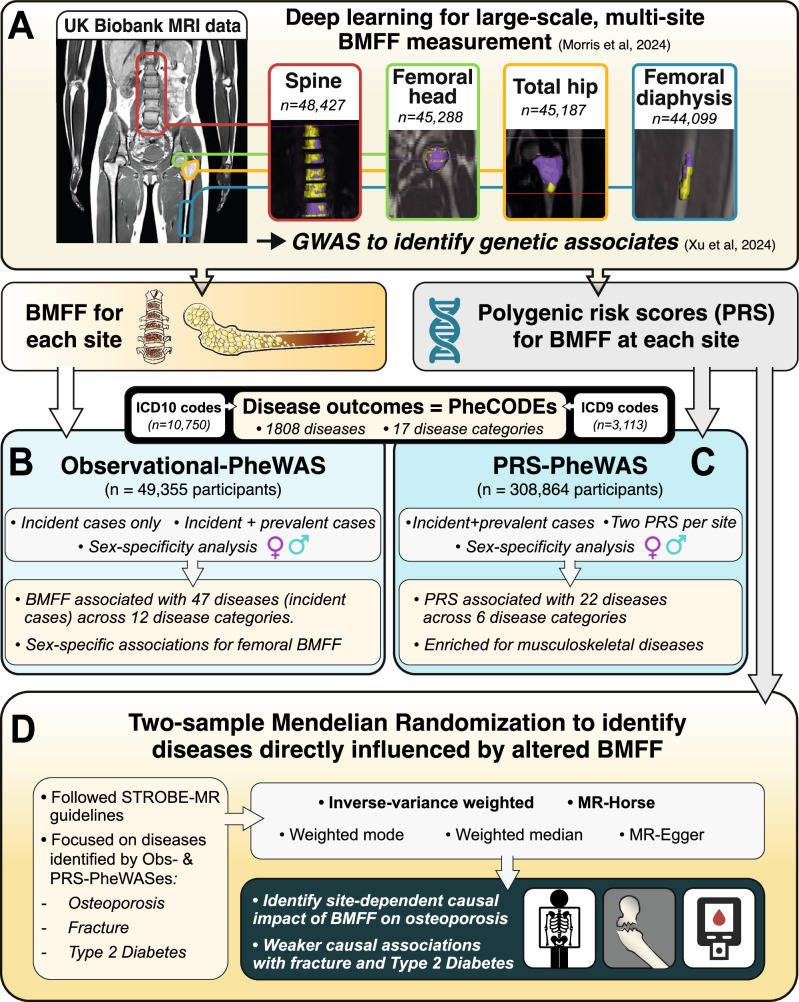Paper of the Month - November 2025
selected by the BMAS Scientific Board
Clinical implications of bone marrow adiposity identified by phenome-wide association and Mendelian randomization in the UK Biobank
- 1 Centre for Global Health, Usher Institute, University of Edinburgh, Edinburgh, UK.
- 2 Institute for Neuroscience and Cardiovascular Research, The University of Edinburgh, Edinburgh, UK.
- 3 Edinburgh Imaging, University of Edinburgh, The Queen’s Medical Research Institute, Edinburgh BioQuarter, 47 Little France Crescent, Edinburgh, UK.
- 4 School of Mathematics and Computer Sciences, Heriot-Watt University, Edinburgh, UK.
- 5 Archimedes Unit, Athena Research Centre, Artemidos 1, Marousi, Greece.
- 6 Univ. Lille, CHU Lille, Marrow Adiposity and Bone Laboratory (MABlab) ULR 4490, Department of Rheumatology, Lille, France.
- 7Department of Big Data in Health Science, School of Public Health and The Second Affiliated Hospital, Zhejiang University School of Medicine, Hangzhou, China.
- 8Medical Research Council Human Genetics Unit, Medical Research Council Institute of Genetics & Molecular Medicine, University of Edinburgh,
Edinburgh, UK. - 9Danish Institute for Advanced Study (DIAS), Epidemiology, Biostatistics and Biodemography, Department of Public Health, University of Southern
Denmark, Odense, Denmark. - 10Centre for Clinical Brain Sciences, University of Edinburgh, The Queen’s Medical Research Institute, Edinburgh BioQuarter, 47 Little
France Crescent, Edinburgh, UK. - 11 Centre for Global Health, Usher Institute, University of Edinburgh, Edinburgh, UK. E.Theodoratou@ed.ac.uk.
- 12 Edinburgh Cancer Research Centre, Institute of Genetics and Cancer, University of Edinburgh, Edinburgh, UK. E.Theodoratou@ed.ac.uk.
- 13 Institute for Neuroscience and Cardiovascular Research, The University of Edinburgh, Edinburgh, UK. W.Cawthorn@ed.ac.uk.
Correspondence:Evropi Theodoratou: E.Theodoratou@ed.ac.uk; William P Cawthorn:W.Cawthorn@ed.ac.uk
Nature Communications 2025 Sep 23;16(1):8332.
PMID: 40987763 | PMCID: PMC12457654 |DOI: 10.1038/s41467-025-63395-1
Abstract
Bone marrow adiposity changes in diverse diseases, but the full scope of these, and whether they are directly influenced by marrow adiposity, remains unknown. To address this, we previously measured the bone marrow fat fraction of the femoral head, total hip, femoral diaphysis, and spine of over 48,000 UK Biobank participants. Here, we first use these data for PheWAS to identify diseases associated with marrow adiposity at each site. This reveals associations with 47 incident diseases across 12 disease categories, including osteoporosis, fracture, type 2 diabetes, cardiovascular diseases, cancers, and other conditions that burden public health worldwide. Intriguingly, type 2 diabetes associates positively with spine bone marrow adiposity but negatively with marrow adiposity at femoral sites. We then establish PRSs based on bone-marrow-fat-fraction-associated SNPs and use PRS-PheWAS and Mendelian randomization to explore causal associations between marrow adiposity and disease. PRS-PheWAS reveals that genetic predisposition to increased marrow adiposity is positively associated with osteoporosis and fractures. Mendelian randomization further suggests that increased marrow adiposity at the diaphysis and total hip is causally associated with osteoporosis. Our findings substantially advance understanding of how marrow adiposity impacts human health and highlight its potential as a biomarker and/or therapeutic target for diverse human diseases.

Figure 1: Fig. 1. Study design. A Deep learning was used to segment the spine, femoral head, total hip, and femoral diaphysis from MRI scans of participants in the UKBB imaging study, allowing BMFF measurements at each site. Genetic associates of BMFF were identified by genome-wide association meta-analyses (GWAS), from which polygenic risk scores (PRS) were established for BMFF at each site. B, C PheCODES were used to classify disease outcomes for phenome-wide association studies (PheWAS). The observational PheWAS (Obs-PheWAS) (B) used BMFF as the predictor, while PRS-PheWAS (C) used PRS as the predictor. D Mendelian Randomization was done, including the Bayesian MR-HORSE method, to assess causal relationships between BMFF at each site and osteoporosis, fracture, and type 2 diabetes. Figure generated using Adobe Illustrator. Images in (A) are reused from our previous publications, under a CC-BY license. Some graphics in (D) are adapted from www.svgrepo.com under an open license.
© 2025. The Author(s).
